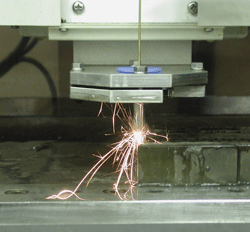- FMA
- The Fabricator
- FABTECH
- Canadian Metalworking
Tips for Improving Small-hole EDM Precision
- By John Marshall
- March 1, 2010
- Article
- Metalworking
Bullet-nosing, a condition describing the tapering that occurs to an electrode, is a common and widespread problem that comes with most EDM drilling operations.
To combat this effect, you should consider several factors when purchasing your next high-speed, small-hole EDM drilling machine tool. Not only should the electrode itself be scrutinized, but also the power source that drives the vaporization of the metal.
A power supply that uses low unload voltage - less than 35 - to burn materials going across EDM drills is one such feature to consider. This low voltage achieves high speeds with low wear on electrodes. The lower voltage is a draw for many people in the metalworking field who have previously chosen other cutting technologies rather than face the EDM cutting problems that a low-voltage power supply can correct.
Most EDM drills run at about 100 V. In these situations, electrode wear can be three times what is created at lower voltages, and a lot of bullet-nosing occurs at the end of the electrode.
A low-voltage power supply burns cleaner, straighter holes with less side gap, which keeps the end of the electrode very sharp. Electrode wear will be reduced, in some cases, to as little as 20 to 25 percent.
Another tip is to use regular tap water, plus an additive, in the operation instead of deionized water, for certain materials such as carbide.
The right system can keep the end of the electrodes very square, and as a result, the bottom of the created holes remains clean when the electrode breaks through.
Sinker Comparison
A shop could achieve comparable, and even better, results with a CNC sinker EDM. However, the sinker machine costs more and requires more time to finish the part run. While a sinker EDM is the right tool for many applications, if tolerance requirements don’t call for one, an EDM drill is probably the more reasonable option.
If your shop has small-hole EDM jobs, closely examine the requirements of the jobs you are quoting and let those dictate the technology you apply. If the job specifies hole diameters in the range of 0.012 to 0.120 in., EDM drills can be the right choice. Anything finer – such as a micromold - and you should look at a sinker EDM unit with a fine-hole attachment.
Most small holes, however, usually require only an EDM drill and run-through on a wire EDM to finish them.
For more information, visit www.mitsubishi-world.com.
Related Companies
subscribe now


Keep up to date with the latest news, events, and technology for all things metal from our pair of monthly magazines written specifically for Canadian manufacturers!
Start Your Free Subscription- Trending Articles
- Industry Events
ZEISS Quality Innovation Days 2024
- April 15 - 19, 2024
Tube 2024
- April 15 - 19, 2024
- Düsseldorf, Germany
CTMA Economic Uncertainty: Helping You Navigate Windsor Seminar
- April 30, 2024
- Windsor, ON Canada
MME Winnipeg
- April 30, 2024
- Winnipeg, ON Canada
CTMA Economic Uncertainty: Helping You Navigate Kitchener Seminar
- May 2, 2024
- Kitchener, ON Canada















